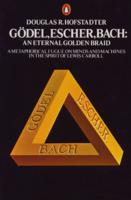Gödel, Escher, Bach
Gödel, Escher, Bach: an Eternal Golden Braid, also known as GEB, is a 1979 book by Douglas Hofstadter. By exploring common themes in the lives and works of logician Kurt Gödel, artist M. C. Escher, and composer Johann Sebastian Bach, the book expounds concepts fundamental to mathematics, symmetry, and intelligence. Through short stories, illustrations, and analysis, the book discusses how systems can acquire meaningful context despite being made of "meaningless" elements. It also discusses self-reference and formal rules, isomorphism, what it means to communicate, how knowledge can be represented and stored, the methods and limitations of symbolic representation, and even the fundamental notion of "meaning" itself. In response to confusion over the book's theme, Hofstadter emphasized that Gödel, Escher, Bach is not about the relationships of mathematics, art, and music—but rather about how cognition emerges from hidden neurological mechanisms. One point in the book presents an analogy about how individual neurons in the brain coordinate to create a unified sense of a coherent mind by comparing it to the social organization displayed in a colony of ants.Gödel, Escher, Bach won the Pulitzer Prize for general non-fiction and the National Book Award for Science Hardcover. Despite the success of the book, Hofstadter felt that audiences did not adequately grasp what he felt was the main idea of the book: strange loops. In an attempt to remedy this, he published I Am a Strange Loop in 2007. Source: Wikipedia (en)
Editions
15- date of publication: 1999ISBN-13: 978-0-465-02656-2
- date of publication: 2000-12-01ISBN-13: 978-0-14-028920-6
- ISBN-13: 978-0-14-005579-5
- ISBN-13: 978-0-14-017997-2
- date of publication: 1979ISBN-13: 978-0-394-74502-2
- date of publication: 1979ISBN-13: 978-0-465-02685-2
Work - wd:Q831517

















